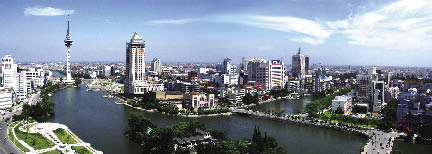| Travel to Nantong
By WU MEILING
BEFORE silt from the Yangtze River and Yellow Sea was deposited millennia ago into what is now the Yangtze River Delta, the area had many tidal sand ridges. Nantong, on the northern bank of the Yangtze River's mouth in Jiangsu Province, was one of these ridges, and 1,000 years ago was known as Hudouzhou, or Broad Bean Tidal Ridge.
During the several centuries comprising the Southern and Northern Dynasties (420-589), and the following Sui (581-618) and Tang (618-907) dynasties, Hudouzhou developed a significant salt industry, which stimulated local population growth and economic prosperity. It later became a strategic riverine gateway in regional power struggles. In 958, during the Later Zhou Dynasty (951-960), the last local regime of the Five Dynasties Period (907-960), a walled city was created here named Tongzhou. In the Qing Dynasty, the imperial court referred to it as Southern Tongzhou to distinguish it from the northern Tongzhou immediately southeast of the imperial capital (the present-day Tongzhou District of Beijing).
As its northern namesake bathed in the proximity of imperial benevolence, Southern Tongzhou quickly developed as an industrial pioneer, along with Shanghai on the other side of the Yangtze. Its geographic position, across the river from Shanghai and fronting the vast plain of northern Jiangsu, has remained a blessed advantage for Nantong. Today, many Shanghai citizens spend their holidays here, enjoying crisp air and bright sunshine more typical of northern China, though in the thick of the rainy season Nantong is not much different from any damp, drizzly southern town. In the words of Mayor Ding Dawei, Nantong has the elegant scenery of southern water towns, as well as the magnificent landscapes of northern cities; it features southern romance as well as northern gallantry; Oriental modesty as well as Occidental modernity. A trip to Nantong allows one to witness the coexistence of all these geographical, climatic and cultural contrasts.
 |
| The beautiful Haohe River. |
The Epic Haohe River
The Haohe River, a moat that surrounded the once walled city, has sustained Nantong for 1,000 years. It is an offshoot of the Yangtze River, and has generated many sand ridges and lakes. In some places, the rippling waters flow in a broad tide, while in other spots the river narrows to a stream spanned by elegant bridges. Today the river is lined by both old abodes and modern structures.
Throughout its history, Nantong has produced many national celebrities. A century ago, one of them distinguished the city as well as himself. Zhang Jian (1853-1926) was a zhuangyuan, or top scorer, in the highest-level imperial examination of the late Qing Dynasty. Zhang Jian devoted himself to running industrial and educational undertakings in his hometown. He launched a spinning mill and a few other light and textile enterprises, introducing the shareholding system to the area. He also brought in modern animal husbandry techniques and financial businesses, and opened China's first museum, teachers' school, textile college, weather station and embroidery school. In addition, Zhang was a philanthropist, running homes for the elderly, orphans and the handicapped, as well as shelters for the homeless. Mao Zedong once commented that China should never forget Zhang Jian for his contribution to the rise of China's light and textile industries.
Many vintage buildings testifying to the industrial powerhouse Zhang Jian established can still be found along the banks of the Haohe River, such as the Nantong Museum, Hanmolin Printing House, Women's Craft School and the Drama School. Some of these structures have been kept as they were, while others have been converted for other uses.
Living in the wake of Zhang Jian's legacy, Nantong people have been carrying his undertakings forward and expanding local development from the Haohe River area to the more expansive Yangtze River and marine coast. Today the Sutong Bridge, the world's largest cable stayed bridge, spans the Yangtze, connecting Nantong with Shanghai and southern Jiangsu. Deep-water wharves have been built where small fishing piers once stood, linking Nantong to the world via global shipping routes. In short, a modern port city has emerged, and today Nantong is one of the few Chinese cities whose GDP exceeds RMB 250 billion. Nantong is also an educational brand name in Jiangsu.
I visited several museums in Nantong, and the most impressive is the Shen Shou Art Gallery, nestled by the Haohe River. It was converted from the Women's Craft School that Zhang Jian established for the embroidery master Shen Shou (1871-1921). It is a two-storied red building that witnessed the birth of the verisimilitude embroidery style created by Shen Shou. Her masterpiece, Italian Queen, won the award for excellence at the 1911 Turin International Exposition in Italy, and her embroidered portrait of Jesus won first prize at the 1915 Panama Pacific International Exposition held in San Francisco.
Shen's embroidered botanical likenesses present viewers with a three-dimensional bloom from whichever angle they are looked at. Her work Clams has charmed viewers with its freshness for a century. Artist Liu Haisu commented that the first person to do sketches in China was neither him nor Xu Beihong, but Shen Shou, who did them with needles. Both Liu Haisu (1895-1992) and Xu Beihong (1895-1953) were leaders of modern art and art education in China.
|
